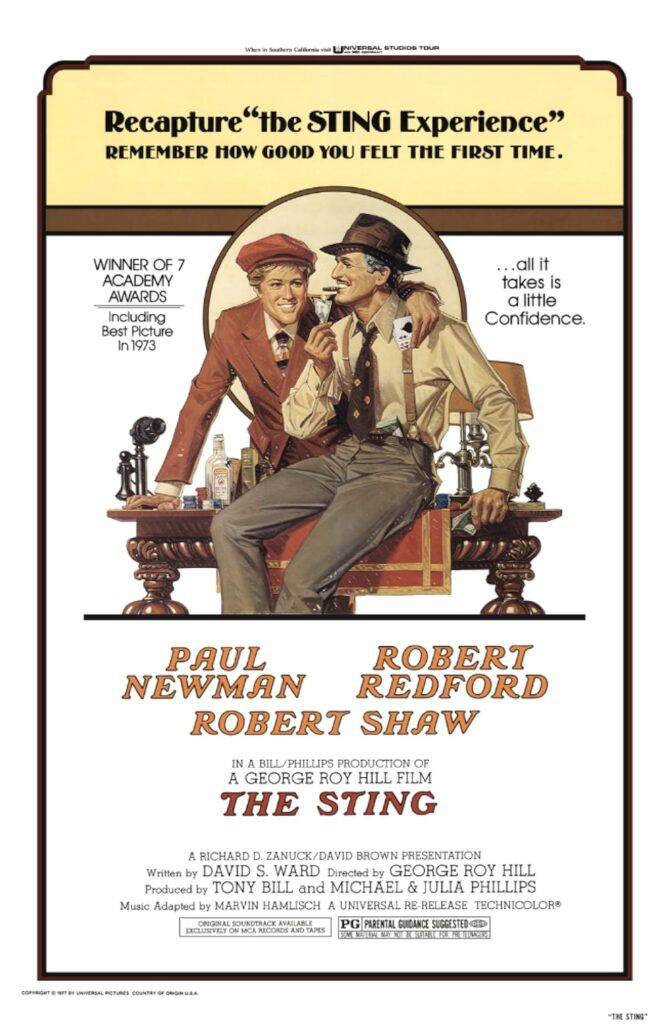By Jalen Maki
Have you ever watched a movie for the first time, thought it was fine, then watched it again later on and realized it absolutely rules?
For me, one of those movies is The Sting.
Released on Christmas Day in 1973 – 50 years ago this week – The Sting stars Paul Newman and Robert Redford and reunites them with Butch Cassidy and the Sundance Kid director George Roy Hill. The film also features Robert Shaw, best known for playing shark hunter Quint in Jaws.

The film, set in 1936, begins with Johnny Hooker (Redford), a young con man in Joliet, Ill., scamming an unsuspecting guy on the street out of a big chunk of change. Hooker, along with job partners Luther Coleman and the Erie Kid, are ecstatic about their lucky score. Luther, an old-timer and veteran of the trade, figures he’ll take his cut and call it a career and tells Hooker he should give up the small-time stuff for something more worthwhile. Luther recommends Hooker go to Chicago to meet his old pal, Henry Gondorff (Newman), and learn how to pull off the “big con.”
Hooker later learns that the guy they ripped off was a money runner for notorious and brutal mob boss Doyle Lonnegan (Shaw, dialing up the menace). Lonnegan’s men kill both the courier and Luther, sending Hooker on the run to Chicago. Hooker finds Gondorff in the Windy City, Gondorff eventually agrees to make a play to take down Lonnegan and get payback for Luther’s death, and we’re off. What follows is the conception and execution of the “big con,” and folks, it is a great time.
Gondorff enlists the help of some fellow swindlers who also knew Luther and want to get revenge against Lonnegan. After finding out that Lonnegan is a high-stakes poker enthusiast, the crew decides to pull a scam called “the wire,” a grift in which a gambler is conned out of a large sum of money at a fake horse betting parlor. The scheme is incredibly elaborate on multiple levels: for starters, they have to find a location for the phony gambling den; then, they have to make it look legit, which requires locating and installing equipment found in such establishments; they also have to recruit a few dozen guys to pose as employees and gamblers. And this is all before Lonnegan’s even involved.
Hooking and reeling Lonnegan in is its own scam – which also might be the most fun stretch of the movie. Gondorff poses as a loud, drunken Chicago bookie named “Shaw” and buys his way into Lonnegan’s poker game on the 20th Century Limited train running between New York City and Chicago. Newman is having an absolute blast in the scene, hilariously annoying and insulting Lonnegan before finally cheating him out of 15 grand. Lonnegan, although a card cheater himself, does not handle this well. Hooker then swoops in, acting as “Kelly,” an employee of “Shaw” who tells the incensed Lonnegan he wants to double-cross his boss and take over his gambling operation, and he needs a hand from Lonnegan to do so. Lonnegan takes the bait, and the “big con” is officially in motion.
I won’t spoil the actual execution of the con, but watching Gondorff, Hooker and the gang meticulously pull it off is riveting. These guys are the epitome of cool – they never get frazzled, and they adapt and adjust on the fly like the pros they are, never breaking a sweat. Newman’s one of the coolest dudes who’s ever been on screen, and his swagger is cranked to 11 throughout.
The Sting is a film that demands the viewer’s full attention. If one conversation, one line of dialogue, or even one quick glance is missed, the intricate house of cards that is the plot might collapse for the viewer, even if the scam itself remains perfectly intact. The Sting is an impressive feat of filmmaking – the complexity of the con is topped only by the deftness of its execution, and it is incredibly fun to be with these guys for a couple of hours as they avenge their fallen friend.
I enjoyed The Sting on my first watch, but in going back and revisiting it a few times, I’ve continued to notice things I hadn’t before, and it adds even more depth to an already engrossing and lively story. Most movies aren’t necessarily rewarding on a continual basis, but The Sting is, unequivocally.
When they first meet, Gondorff informs Hooker of the importance of the grift’s longevity. “You have to keep this con even after you take his money,” Gondorff says. “He can’t know you took him.” Like the con, The Sting, similarly, has endured – 50 years after its release, it holds up as well as any movie of its era.
Follow Jalen on Letterboxd at www.letterboxd.com/jalenmaki182/ to see what he’s been watching, and read more at www.medium.com/@jalenmaki.
